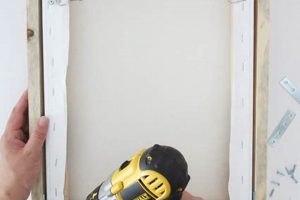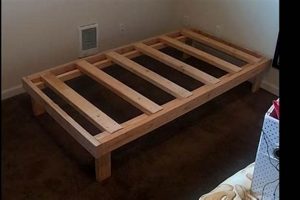Constructing a sleeping platform from repurposed shipping components represents an exercise in sustainable and cost-effective furniture creation. This approach involves disassembling, modifying, and reassembling standardized wooden platforms to create a structurally sound and aesthetically customized base for a mattress.
The practice offers a viable alternative to conventional bed frames, minimizing material waste and providing an opportunity to personalize bedroom dcor. Furthermore, this approach often reduces expenditures associated with purchasing new furniture, while also offering a robust and durable support structure. The rise in popularity of this method reflects a growing interest in upcycling and environmentally conscious consumption.
Subsequent sections will detail the specific procedures involved in material selection, preparation, assembly techniques, and finishing options relevant to building a sturdy and visually appealing platform for supporting a mattress.
Essential Considerations for Pallet Bed Construction
Successfully building a bed structure from reclaimed shipping components requires careful planning and execution. The following guidelines offer critical insights for a safe and aesthetically pleasing outcome.
Tip 1: Source Selection: Prioritize heat-treated pallets marked with “HT,” indicating they have been sterilized without harmful chemicals. Avoid pallets labeled “MB,” which signifies methyl bromide fumigation, a toxic process.
Tip 2: Thorough Inspection: Before use, meticulously examine each pallet for structural integrity. Discard any with visible signs of rot, mold, excessive damage, or pest infestation.
Tip 3: Comprehensive Cleaning: Employ a stiff brush and a solution of diluted bleach to thoroughly clean each pallet. Allow ample time for complete drying to prevent mold growth.
Tip 4: Sanding and Smoothing: Use coarse-grit sandpaper to remove splinters and rough edges. Progress to finer grits for a smooth surface, minimizing the risk of injury.
Tip 5: Secure Fastening: Utilize screws, rather than nails, for assembling the structure. Screws provide a stronger and more durable connection, enhancing the bed frame’s stability.
Tip 6: Proper Support: Depending on the mattress size and pallet configuration, consider adding additional internal support beams to prevent sagging and ensure even weight distribution.
Tip 7: Consider Dimensions: Accurately measure the mattress dimensions to determine the required pallet arrangement. Account for any desired overhang or platform extensions.
Adhering to these recommendations will significantly contribute to the structural integrity, safety, and aesthetic appeal of the finished bed platform. Rigorous attention to material selection, preparation, and assembly is paramount.
The subsequent section provides guidance on finishing and customization options to further personalize the pallet-based sleeping structure.
1. Pallet Selection
The selection of appropriate shipping components represents a foundational decision in the construction of a bed frame utilizing repurposed wooden platforms. The choice directly influences the structural integrity, safety, and overall aesthetic of the final product. For instance, the use of pallets treated with methyl bromide poses a significant health risk due to residual toxicity, rendering them unsuitable for indoor use. Conversely, pallets marked with “HT,” indicating heat treatment, present a safer and more environmentally sound option. This initial selection dictates the subsequent steps and potential success of the entire building process.
Different pallet types exhibit varying load-bearing capacities and wood densities. Choosing pallets designed for heavy loads is critical for constructing a stable and durable bed frame, particularly for larger mattresses or supporting multiple occupants. A common failure mode in amateur projects involves using lightweight or damaged components, leading to structural instability and potential collapse. A well-informed choice of the raw materials, therefore, mitigates the risk of premature failure and enhances the longevity of the bed frame.
Ultimately, the careful consideration of pallet sourcing, treatment methods, and structural characteristics forms the bedrock upon which a successful repurposed bed frame rests. Disregarding these factors introduces significant risks, while informed selection promotes a safe, durable, and aesthetically pleasing outcome. The selection stage is not merely a preliminary step but an integral determinant of the project’s overall success.
2. Structural Integrity
Structural integrity constitutes a paramount consideration when constructing a sleeping platform from reclaimed shipping components. The long-term stability and safety of the bed frame directly correlate to the structural soundness of the individual pallets and the overall assembly method. Compromised integrity can lead to instability, potential collapse, and subsequent injury.
- Material Condition Assessment
Evaluating the condition of each pallet is critical. Signs of rot, insect infestation, or significant damage necessitate rejection. The wood must be free from decay and capable of bearing the intended load. Pallets exhibiting compromised areas undermine the overall structural capacity of the bed frame, introducing points of weakness and potential failure under stress.
- Fastener Selection and Application
Employing screws instead of nails represents a significant improvement in structural stability. Screws provide superior holding power and resistance to pull-out, particularly under repeated stress. Correct screw length and proper torque application are essential to ensure secure connections without splitting the wood. Insufficient fastening compromises joint strength and increases the risk of component separation.
- Weight Distribution and Support
Uneven weight distribution can concentrate stress on specific points, leading to deformation or fracture. Internal support structures, such as additional wooden beams or metal reinforcements, distribute the load more evenly across the entire frame. The quantity and placement of these supports depend on the mattress size, weight, and intended occupancy. Inadequate support results in sagging, instability, and reduced lifespan of the bed frame.
- Joint Reinforcement Techniques
Strengthening joints through the use of metal brackets, wood glue, or interlocking designs enhances structural rigidity. Reinforcements at critical stress points, such as corners and load-bearing connections, prevent racking and improve resistance to lateral forces. Poorly reinforced joints are prone to loosening, creating instability and diminishing the overall integrity of the structure.
Therefore, ensuring adequate structural integrity is not merely an aesthetic consideration; it directly impacts the safety and longevity of the sleeping platform. Rigorous inspection, proper fastening techniques, effective weight distribution, and robust joint reinforcement are all essential elements in creating a stable and reliable bed frame from repurposed shipping components.
3. Surface Treatment
Surface treatment constitutes a critical phase in the construction of a bed frame using repurposed shipping components. The procedures employed directly affect the safety, durability, and aesthetic appeal of the final product. Careful execution mitigates risks associated with reclaimed materials and enhances the longevity of the finished structure.
- Sanding and Smoothing
Sanding removes splinters, sharp edges, and rough surfaces, creating a safer and more comfortable sleeping environment. Progression through varying grits of sandpaper, from coarse to fine, achieves a consistently smooth texture. Inadequate sanding leaves the surface prone to snagging bedding or causing injury. This is a pivotal stage in preparation.
- Cleaning and Disinfecting
Thorough cleaning eliminates dirt, debris, and potential contaminants from the reclaimed wood. A diluted bleach solution can disinfect the material, mitigating the risk of mold growth or pest infestation. Insufficient cleaning can compromise hygiene and contribute to material degradation over time. Careful cleaning ensures the wood is properly prepared for finish.
- Sealing and Protection
Applying a sealant protects the wood from moisture absorption, preventing warping, cracking, and rot. Sealants also create a barrier against stains and facilitate easier cleaning. Inadequate sealing leaves the wood vulnerable to environmental damage and reduces its lifespan. A proper seal protects the pallet wood from moisture and damage.
- Finishing and Aesthetics
The application of paint, stain, or varnish enhances the visual appeal of the bed frame. These finishes offer a range of customization options, allowing for the creation of a unique and personalized aesthetic. Improperly applied finishes can chip, peel, or fade, detracting from the overall appearance and requiring maintenance. The final treatment layer protects the wood and also enhances the pallet’s appearance.
Proper surface treatment is thus integral to transforming reclaimed shipping components into a safe, durable, and aesthetically pleasing bed frame. The careful execution of sanding, cleaning, sealing, and finishing procedures ensures a long-lasting and comfortable sleeping platform.
4. Assembly Method
The method employed in assembling a bed frame from repurposed shipping components directly dictates its stability, longevity, and overall safety. Careful consideration of joint types, fastening techniques, and structural reinforcement is paramount to achieving a robust and reliable sleeping platform.
- Joint Selection and Execution
The selection of appropriate joint types such as butt joints, lap joints, or mortise and tenon joints significantly impacts the structural integrity of the bed frame. Each joint possesses varying strengths and complexities, requiring different skill levels and tools for proper execution. Improperly executed joints represent weak points within the structure, potentially leading to instability and eventual failure. The accuracy of the cutting and fitting processes is crucial for maximizing joint strength.
- Fastener Application and Placement
The choice of fasteners screws, bolts, or specialized connectors and their proper application are essential for securing the joints and distributing stress effectively. Screws generally offer superior holding power compared to nails, particularly in wood subjected to repeated stress. The placement of fasteners should align with load-bearing points and avoid areas prone to splitting or cracking. Over-tightening fasteners can damage the wood, while under-tightening can compromise joint stability.
- Structural Reinforcement Techniques
Employing reinforcement techniques, such as metal brackets, wooden gussets, or strategically placed support beams, enhances the overall stability and load-bearing capacity of the bed frame. These reinforcements provide additional support at critical stress points, preventing racking and minimizing the risk of deformation. The selection and placement of reinforcement components should be tailored to the specific design and anticipated load of the bed frame.
- Leveling and Alignment Considerations
Ensuring proper leveling and alignment during the assembly process is crucial for preventing uneven weight distribution and potential structural imbalances. Accurate measurements and the use of leveling tools ensure that the bed frame sits squarely on the floor, minimizing stress on individual components. Misalignment can lead to rocking, instability, and premature wear on joints and fasteners.
The assembly method constitutes a critical determinant of the success of a repurposed shipping component bed frame. A well-planned and executed assembly, incorporating appropriate joint types, secure fastening techniques, strategic reinforcement, and precise alignment, results in a durable, safe, and aesthetically pleasing sleeping platform. Conversely, a poorly executed assembly compromises the structural integrity of the bed frame and increases the risk of premature failure.
5. Support System
The support system inherent in a reclaimed shipping component bed frame plays a critical role in ensuring structural integrity, weight distribution, and overall longevity. The effectiveness of the support system directly impacts the comfort and safety of the sleeping platform.
- Central Load-Bearing Structure
A central load-bearing structure, often consisting of additional wooden beams or metal supports, distributes weight evenly across the pallet framework. Without such a structure, the mattress weight can concentrate in specific areas, leading to sagging or structural failure. For instance, a queen-sized mattress requires significantly more support than a twin-sized mattress, necessitating a robust central structure.
- Leg Placement and Distribution
The placement and distribution of legs or support points are crucial for preventing uneven weight distribution and potential instability. Legs must be strategically positioned at regular intervals to provide consistent support across the entire bed frame. Insufficient or improperly placed legs can result in rocking or wobbling, compromising the stability and safety of the structure.
- Foundation Material and Ground Contact
The type of material used for the bed frame’s foundation and its contact with the ground influence its overall stability and load-bearing capacity. A solid, level surface is essential for ensuring even weight distribution. Placing the bed frame on an uneven surface can create stress points and increase the risk of structural damage. Protective pads or leveling feet can mitigate these issues.
- Joint Reinforcement at Support Points
Reinforcing joints at key support points, such as corners and leg attachments, enhances the structural integrity of the support system. Metal brackets, wooden gussets, or specialized connectors can strengthen these connections, preventing racking and minimizing the risk of joint failure under load. Adequate joint reinforcement at support points is critical for ensuring long-term stability and preventing premature wear.
In conclusion, the support system within a reclaimed shipping component bed frame is not merely an ancillary component but an integral element that directly impacts its safety, stability, and longevity. Careful consideration of the central load-bearing structure, leg placement, foundation material, and joint reinforcement ensures a reliable and comfortable sleeping platform.
6. Size Adaptation
The process of adapting a sleeping platform constructed from reclaimed shipping components necessitates careful consideration of dimensional parameters. Accurate sizing ensures compatibility with standard mattress dimensions and optimizes space utilization within the intended room. Neglecting proper size adaptation can result in an unstable or unusable structure.
- Mattress Compatibility
Adapting the pallet arrangement to match standard mattress sizes (twin, full, queen, king, etc.) is crucial. Discrepancies between the frame and mattress dimensions can lead to uneven support, mattress slippage, and accelerated wear. Exact measurements are imperative for a secure and comfortable fit.
- Room Dimensions and Spatial Constraints
The size of the room dictates the maximum permissible dimensions of the bed frame. Overly large structures can impede movement and create a sense of claustrophobia. Careful measurement of the available space and consideration of other furniture placements are essential for optimizing room functionality.
- Pallet Modification Techniques
Size adaptation often requires modifying individual pallets through cutting, trimming, or disassembly and reassembly. These techniques demand precision and a thorough understanding of structural integrity. Incorrect modifications can compromise the strength and stability of the frame.
- Customization for Unique Spaces
Repurposed shipping component structures allow for customization to fit unconventional room layouts or specific design requirements. This adaptability is advantageous in situations where standard bed frames are unsuitable. Bespoke sizing requires meticulous planning and accurate execution.
These facets of size adaptation collectively contribute to the functional and aesthetic success of a sleeping platform made from repurposed shipping components. Proper planning and execution ensure a secure, comfortable, and visually harmonious addition to the living space.
7. Finishing Options
The selection of appropriate finishing options represents a critical decision point in the creation of a sleeping platform from reclaimed shipping components. These choices directly influence the bed frame’s aesthetic appeal, durability, and protection against environmental factors. The application of finishes transforms the raw material into a functional and visually cohesive piece of furniture.
- Protective Sealants and Coatings
The application of sealants and coatings, such as polyurethane or varnish, provides a protective barrier against moisture, scratches, and wear. This enhances the longevity of the wooden structure, preventing warping, cracking, and rot. Specific formulations offer UV protection, mitigating fading caused by sunlight exposure. For instance, applying a marine-grade varnish to a pallet bed frame intended for outdoor use provides superior resistance to the elements.
- Paint and Stain Applications
Paint and stain options offer extensive customization possibilities, allowing for the integration of the pallet bed frame into various design schemes. Paint provides complete color coverage, while stain enhances the natural wood grain and texture. The selection of appropriate primers and topcoats is crucial for achieving a durable and aesthetically pleasing finish. For example, a whitewashed stain can create a rustic, farmhouse-style aesthetic, while a dark wood stain imparts a more traditional and sophisticated appearance.
- Textural Treatments and Embellishments
Beyond simple color application, various textural treatments can add visual interest and tactile appeal to the pallet bed frame. These treatments include distressing techniques, such as sanding or wire brushing, to create a weathered appearance. Embellishments, such as stenciled designs or decorative hardware, can further personalize the finished product. The strategic use of these treatments transforms the pallet frame into a unique focal point within the bedroom.
- Eco-Friendly and Non-Toxic Finishes
Given the increasing awareness of environmental and health concerns, the selection of eco-friendly and non-toxic finishes is paramount. Water-based paints, stains, and sealants minimize VOC emissions and reduce the risk of exposure to harmful chemicals. The use of natural oils and waxes provides a sustainable alternative to conventional finishing products. Prioritizing these options aligns with the principles of sustainable furniture construction and promotes a healthier indoor environment.
These diverse finishing options offer ample opportunities to personalize a sleeping platform constructed from repurposed shipping components. The careful selection and application of these finishes significantly enhance the aesthetic appeal, durability, and environmental sustainability of the resulting bed frame.
Frequently Asked Questions
The subsequent questions address prevalent concerns and misconceptions associated with constructing bed frames from repurposed wooden platforms. The information provided aims to offer clarity and inform decision-making.
Question 1: Are all shipping components suitable for constructing a bed frame?
No, not all shipping components are suitable. Those treated with methyl bromide (MB) pose health risks and should be avoided. Components marked “HT” (heat-treated) are generally a safer alternative. Visual inspection for rot, mold, pest infestation, and structural damage is crucial for ensuring suitability.
Question 2: Is a platform made from repurposed wood structurally sound enough to support a mattress and occupants?
Yes, if constructed properly. Proper construction necessitates selecting structurally sound components, employing robust fastening techniques (screws over nails), and incorporating adequate internal support structures to distribute weight evenly. Adherence to established construction principles is critical for achieving sufficient structural integrity.
Question 3: Does building a sleeping platform from reclaimed wood present hygiene concerns?
Potential hygiene concerns exist. Thorough cleaning and disinfection are essential to remove dirt, debris, and potential contaminants. A diluted bleach solution can be employed, followed by complete drying. Sealing the wood after cleaning provides an additional layer of protection against moisture and microbial growth.
Question 4: How does one address splinters and rough surfaces on reclaimed wood?
Sanding is the primary method for addressing splinters and rough surfaces. Employ coarse-grit sandpaper initially, followed by progressively finer grits to achieve a smooth texture. Wearing appropriate personal protective equipment (gloves, mask) during sanding is recommended to prevent injury and dust inhalation.
Question 5: What are the legal implications of using reclaimed shipping components?
Legal implications are generally minimal, provided the components are obtained legally. Purchasing from reputable sources or acquiring permission to reclaim discarded components mitigates potential legal issues. Transporting large quantities of components may be subject to local regulations.
Question 6: What is the expected lifespan of a sleeping platform built from reclaimed wood?
The lifespan varies depending on the quality of materials, construction techniques, and environmental conditions. A well-constructed and maintained frame can last for many years. Regular inspection and maintenance are recommended to address any signs of wear or damage promptly.
In summary, while constructing a sleeping platform from reclaimed shipping components offers numerous benefits, including cost savings and environmental sustainability, addressing these frequently asked questions is crucial for ensuring a safe, durable, and legally compliant outcome.
The next section provides information on long-term maintenance and care of such structures.
Conclusion
This exploration of constructing a diy bed frame using pallets has illuminated the critical factors influencing safety, durability, and aesthetic outcomes. The analysis encompasses material selection, structural engineering principles, surface treatment protocols, and the significance of proper assembly and support systems. Furthermore, considerations for size adaptation and appropriate finishing options were detailed to provide a comprehensive understanding of the process.
Ultimately, the creation of a functional and enduring sleeping platform from repurposed shipping components demands meticulous planning, diligent execution, and a thorough awareness of potential challenges. By adhering to the outlined guidelines and prioritizing safety, individuals can effectively transform reclaimed materials into a sustainable and personalized furnishing. The successful implementation of such a project not only provides a cost-effective sleeping solution but also promotes environmentally conscious practices.


![Build a Strong DIY Boxing Bag Frame [Project Guide] The DIY Hub: Creative Crafts, Repairs & Life Hacks Build a Strong DIY Boxing Bag Frame [Project Guide] | The DIY Hub: Creative Crafts, Repairs & Life Hacks](https://craftingdiycenter.com/wp-content/uploads/2025/07/th-2040-300x200.jpg)




